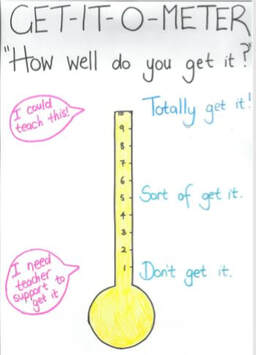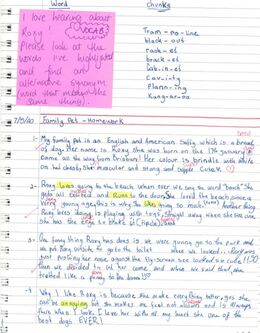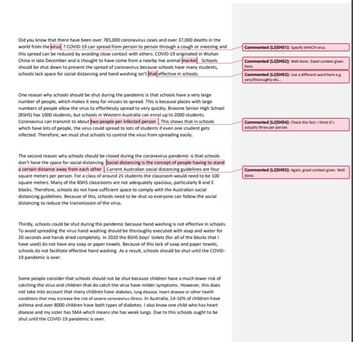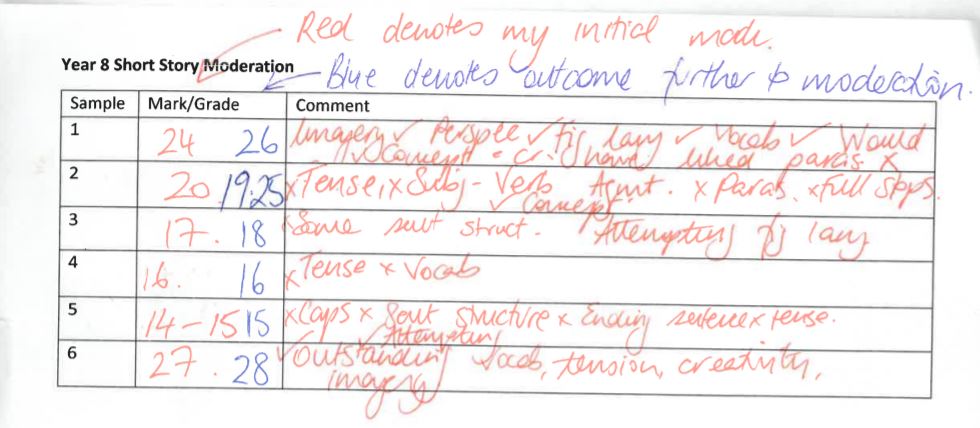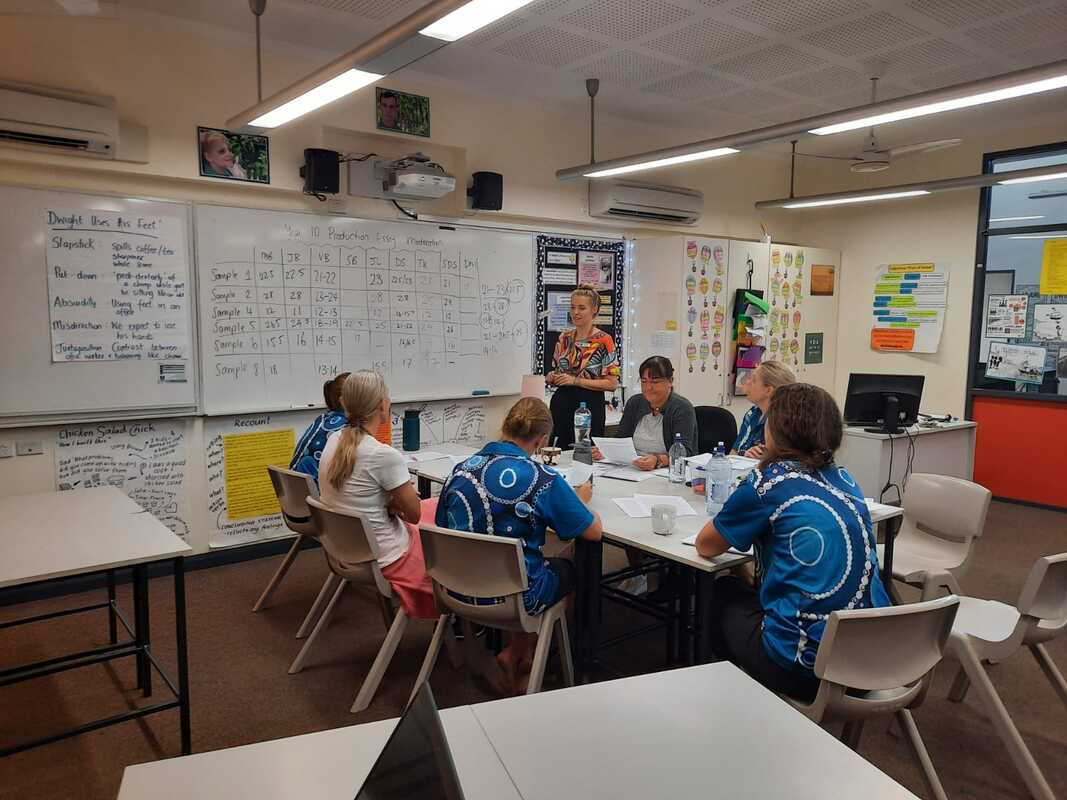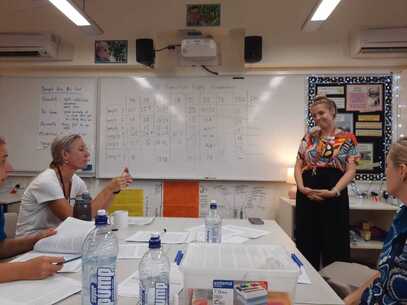Focus area 5.1. Assess student learning
Develop select and use informal and formal, diagnostic, formative and summative assessment strategies to assess student learning.
Assessment forms a fundamental part of the teaching, learning and assessment cycle. To that end, my planning takes a backward-mapping approach, whereby learning outcomes are established at the beginning of the process, then the nature of assessment defined and finally, appropriate content decided upon.
In terms of diagnostic assessment, for the third week of Term One in 2019, I supported a Pre-primary class in conducting on-entry assessment in numeracy and literacy, as part of the school's whole-school assessment process. This was insightful in terms of identifying common age-appropriate learning patterns and errors, and recognising the commonalities in developmental trajectories. It was also helped me recognise the centrality of the 'big ideas' - place values, partitioning, conservation of mass and volume - to numeracy and why we deliver learning experiences with those big ideas in mind.
I use formative assessment as part of every lesson, in order to ensure that I am on track with learning objectives. Strategies include using a traffic light system to check for understanding (green light for yes, red light for no, amber light for 'more clarity needed') and using mini-whiteboards to elicit responses from students in order to monitor responses. Frequently, I use checklists as a simple tool to track student performance against learning goals. I find these an efficient way to collect and store data and observe areas of common misconceptions or errors. By way of example, the redacted checklist shown here was used to collect data regarding student performance of this task on number sense.
Simple strategies such as the 'Get-it-o-meter', shown below, have been used as a formative assessment tool to gauge student understanding of content.
Develop select and use informal and formal, diagnostic, formative and summative assessment strategies to assess student learning.
Assessment forms a fundamental part of the teaching, learning and assessment cycle. To that end, my planning takes a backward-mapping approach, whereby learning outcomes are established at the beginning of the process, then the nature of assessment defined and finally, appropriate content decided upon.
In terms of diagnostic assessment, for the third week of Term One in 2019, I supported a Pre-primary class in conducting on-entry assessment in numeracy and literacy, as part of the school's whole-school assessment process. This was insightful in terms of identifying common age-appropriate learning patterns and errors, and recognising the commonalities in developmental trajectories. It was also helped me recognise the centrality of the 'big ideas' - place values, partitioning, conservation of mass and volume - to numeracy and why we deliver learning experiences with those big ideas in mind.
I use formative assessment as part of every lesson, in order to ensure that I am on track with learning objectives. Strategies include using a traffic light system to check for understanding (green light for yes, red light for no, amber light for 'more clarity needed') and using mini-whiteboards to elicit responses from students in order to monitor responses. Frequently, I use checklists as a simple tool to track student performance against learning goals. I find these an efficient way to collect and store data and observe areas of common misconceptions or errors. By way of example, the redacted checklist shown here was used to collect data regarding student performance of this task on number sense.
Simple strategies such as the 'Get-it-o-meter', shown below, have been used as a formative assessment tool to gauge student understanding of content.
Focus area 5.2 - Provide feedback to students on their learning.
Provide timely, effective and appropriate feedback to students about their achievement relative to their learning goals.
During my time teaching High School English, one of the best ways I collected data and provided feedback was through dialogue journals. Dialogue journals are a two-way communication process, where students and I write an informal letter to each other once a week. This allowed us to develop a relationship and allowed me to identify areas for future learning, in a risk-free manner. I would respond to students and then in a later lesson would offer a specific piece of feedback gained during the journal-writing 'e.g Meg, your voice is very clear in your writing, but might be better evident if you could use paragraphs to separate topics. Great work!' The example shown here, demonstrates how the journal often became a two-way process where students, in a very organic and authentic sort of way, responded to my feedback with their own commentary. This was a surprising and very welcome occurrence!
Feedback to students on learning took was regular, measurable and specific, as exemplified below.
Provide timely, effective and appropriate feedback to students about their achievement relative to their learning goals.
During my time teaching High School English, one of the best ways I collected data and provided feedback was through dialogue journals. Dialogue journals are a two-way communication process, where students and I write an informal letter to each other once a week. This allowed us to develop a relationship and allowed me to identify areas for future learning, in a risk-free manner. I would respond to students and then in a later lesson would offer a specific piece of feedback gained during the journal-writing 'e.g Meg, your voice is very clear in your writing, but might be better evident if you could use paragraphs to separate topics. Great work!' The example shown here, demonstrates how the journal often became a two-way process where students, in a very organic and authentic sort of way, responded to my feedback with their own commentary. This was a surprising and very welcome occurrence!
Feedback to students on learning took was regular, measurable and specific, as exemplified below.
I have also provided feedback to students further to exams. I have sought to make exam feedback a two-way process, asking students to complete post-exam surveys in order to provide me as teacher with constructive feedback on the fairness of exams, as shown here.
Focus area 5.3 - Make consistent and comparable judgements.
Understand and participate in assessment moderation activities to support consistent and comparable judgements of student learning.
Moderation is a process undertaken routinely each semester in the English Department at Broome Senior High School. The photos shown immediately below were taken from a session where all English teachers participated in moderating a Year 10 ARC (Academic Rigour Course) assessment. Student samples were provided in advance by the Head of Learning Area. Teachers individually graded these samples, then gathered together for moderation to compare and contrast judgements that had been made. An email to the facilitator, shown here, demonstrates my reflection on this process.
In a further session, moderating Year 8 work samples, I gained further confidence in my ability make consistent and comparable judgements as the marks I gave were bolstered and reaffirmed through the moderation process. The photos below show the marks I provided compared with the final ones allocated further to the moderation process. The actual work samples assessed as part of this moderation exercise are shown here.
Understand and participate in assessment moderation activities to support consistent and comparable judgements of student learning.
Moderation is a process undertaken routinely each semester in the English Department at Broome Senior High School. The photos shown immediately below were taken from a session where all English teachers participated in moderating a Year 10 ARC (Academic Rigour Course) assessment. Student samples were provided in advance by the Head of Learning Area. Teachers individually graded these samples, then gathered together for moderation to compare and contrast judgements that had been made. An email to the facilitator, shown here, demonstrates my reflection on this process.
In a further session, moderating Year 8 work samples, I gained further confidence in my ability make consistent and comparable judgements as the marks I gave were bolstered and reaffirmed through the moderation process. The photos below show the marks I provided compared with the final ones allocated further to the moderation process. The actual work samples assessed as part of this moderation exercise are shown here.
Focus area 5.4 - Interpret student data.
Use student assessment data to analyse and evaluate student understanding of subject/content, identifying interventions and modifying teaching practice.
Use student assessment data to analyse and evaluate student understanding of subject/content, identifying interventions and modifying teaching practice.
Focus area 5.5 - Report on student achievement.
Report clearly, accurately and respectfully to students and parents/carers about student achievement, making use of accurate and reliable records.
As an employee of the Department of Education, Western Australia, I used their Reporting to Parents system for reporting to parents and/or carers on student achievement. The screen shot shown here provides evidence of using this system. Redacted samples of end of semester reporting are shown here.
Report clearly, accurately and respectfully to students and parents/carers about student achievement, making use of accurate and reliable records.
As an employee of the Department of Education, Western Australia, I used their Reporting to Parents system for reporting to parents and/or carers on student achievement. The screen shot shown here provides evidence of using this system. Redacted samples of end of semester reporting are shown here.
